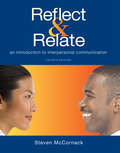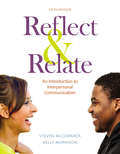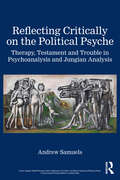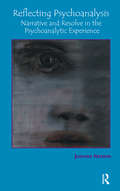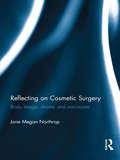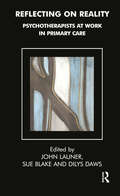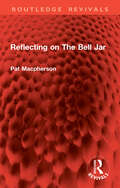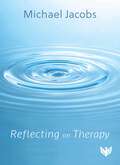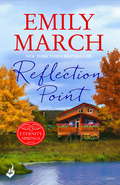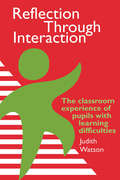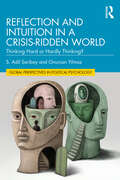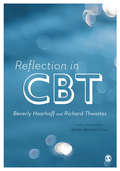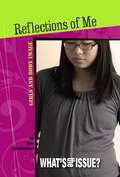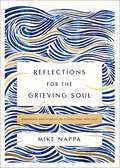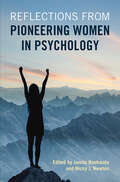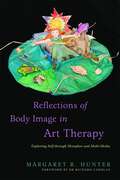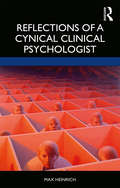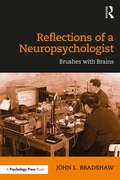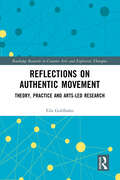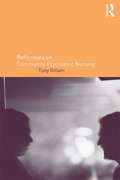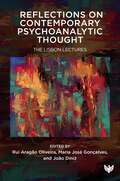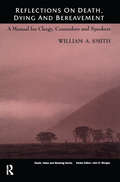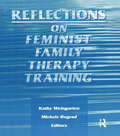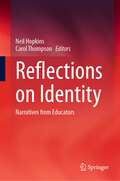- Table View
- List View
Reflect & Relate
by Steven MccornackIn Reflect & Relate, distinguished teacher and scholar Steve McCornack provides students with the best theory and most up-to-date research and then helps them relate that knowledge to their own experiences. Engaging examples and a lively voice hook students into the research, while the book's features all encourage students to critically reflect on their own experiences. Based on years of classroom experience and the feedback of instructors and students alike, every element in Reflect & Relate has been carefully constructed to give students the practical skill to work through life's many challenges using better interpersonal communication. The new edition is thoroughly revised with a new chapter on Culture; new, high-interest examples throughout; and up-to-the-moment treatment of mediated communication, covering everything from Internet dating to social media. Reflect & Relate, Fourth Edition has its own dedicated version of Bedford/St. Martin's LaunchPad, which brings together all of the book's student and instructor media, making this a truly integrated print/interactive resource.
Reflect & Relate: An Introduction To Interpersonal Communication
by Steven McCornack Kelly MorrisonIn Reflect & Relate, distinguished teacher and scholar Steve McCornack provides students with the best theory and most up-to-date research and then helps them relate that knowledge to their own experiences. Engaging examples and a lively voice hook students into the research, while the book's features all encourage students to critically reflect on their own experiences. Based on years of classroom experience and the feedback of instructors and students alike, every element in Reflect & Relate has been carefully constructed to give students the practical skill to work through life’s many challenges using better interpersonal communication. The new edition is thoroughly revised with a new chapter on Culture; new, high-interest examples throughout; and up-to-the-moment treatment of mediated communication, covering everything from Internet dating to social media.
Reflecting Critically on the Political Psyche: Therapy, Testament and Trouble in Psychoanalysis and Jungian Analysis
by Andrew SamuelsWith passion and originality, within this new book, Samuels presents powerful material on culture and politics (including a critical take on political violence) and a compassionate account of the role of an individual when it comes to progressive politics.Initial chapters include his commentary on Edward Albee’s shocking play The Goat and a provocative and critical view on liberal idealisation of ‘the Other’. Then, there is more of Samuels’ celebrated work bringing therapy thinking to bear on politics, and as far as the practice and organisation of therapy is concerned, readers will find new work on how to organise a good training (you must use pluralism) and a robust account of what a critical psychotherapy might look like. A section on Jungian matters includes Samuels’ work on Jung and ‘Africans’, whose importance has long been recognised, and a scintillating ‘balance sheet’ for Jungian analysis, setting its strengths and weaknesses alongside each other. In a clinical section, Samuels shows us what he means by the dynamic idea of the ‘activist client’.With each chapter being preceded by a special ‘retrospective introduction’, as well as including experiential exercises to ground the ideas, this unique collection of papers will be of interest to psychotherapists, Jungian analysts, psychoanalysts, and counsellors, as well as academics working in those fields.
Reflecting Psychoanalysis: Narrative and Resolve in the Psychoanalytic Experience
by Jurgen ReederAt the heart of this book is an ethical question: 'With what legitimacy do I assume the right to interpret my fellow being?' This question is raised in the context of a critique of a particular hermeneutic interpretation of psychoanalysis, namely, psychoanalysis as an objectifying discipline in which the other (the analysand) is regarded quintessentially as a representation or exterior object to be understood. The author embraces the fundamental intersubjectivity of psychoanalytic experience. Intersubjectivity is viewed as the human encounter within the psychoanalytic setting where there occurs a mutual influencing or acting upon, rather than an encounter guided by an essentially objectivating scientific knowledge. Truth in this conception is not a cumulatively acquired possession, but an always-emerging process coiled within an interpretative dialectic occurring between human beings. This is a thoughtful, nuanced, clearly articulated and challenging book that engages directly with the perceived crisis of psychoanalysis.
Reflecting on Cosmetic Surgery: Body image, Shame and Narcissism
by Jane Megan NorthropCosmetic surgery represents an extreme form of modern grooming. It is the fastest growing medical specialty, yet misconceptions abound about those who undertake it and their reasons for doing so. With a grounded approach, engaging 30 women through in-depth interview, this study explores how they chose cosmetic surgery as an option. Their accounts frame a theoretical discussion, in which Northrop proposes that cosmetic surgery is initiated within the vulnerable and divisive relationship between the self and its poor body image. Poor body image and the attempt at its reparation are examined conceptually through shame and narcissism. With compelling case studies and a multi-disciplinary approach, Reflecting on Cosmetic Surgery demonstrates that shame constitutes a framework through which we formulate appearance norms and learn the art of becoming socially embodied. Shame concerns the self, but manifests in response to perceived social phenomena. Through the evaluation and amendment of body image with cosmetic surgery, notions of self and social worthiness are played out. Northrop argues convincingly for a review of the way in which we view narcissism and proposes that shame, and the discomforts arising from it, are implicated in its occurrence. This book will appeal to students and scholars across the social sciences, and particularly in women’s studies and gender studies.
Reflecting on Reality: Psychotherapists at Work in Primary Care (Tavistock Clinic Series)
by John Launer Dilys Daws Sue BlakePrimary care and psychotherapy are in some ways worlds apart. Yet both deal with the same human fundamentals: birth, and death, hope and disappointment, identity and uncertainty. This innovative book looks at how psychotherapists can make use of their skills in primary care. It examines how therapists, family physicians and other primary care professionals can all learn from each other through clinical collaboration. Each chapter describes a different practical approach to joint working in a range of primary care settings, across the life cycle. Specific topics include services for children and adolescents, working with immigrants, and live supervision. All the authors are connected with the Tavistock Clinic, and are psychotherapists or family physicians. The book challenges psychotherapists and those who work in primary care to develop closer working relationships, so that they can deliver more effective and more equitable services.
Reflecting on The Bell Jar (Routledge Revivals)
by Pat MacphersonIn the 1950s, America was in the grip of Cold War paranoia and McCarthyism. Communism and ‘gender maladjustment’ were twin threats to the social ideals of family and security. Yet, previous readings of Plath and her heroine have ignored much of the social context of this era.Reflecting on The Bell Jar (first published in 1991) acknowledges this repressive post-war regime of social hygiene. Pat Macpherson’s reading takes into account the fundamental rearrangement of the social contract between citizen and state, built on the newly made connections between national security and mental health. She investigates the trial of the Rosenbergs and its connections with the electrotherapy Plath and her heroine both experience. Macpherson also evaluates the coercive effects of society’s self-imposed inquisitional attitude of surveillance and explores its role in forming female identity. Esther Greenwood, says Macpherson, is the first heroine of our own era of popularized therapeutic culture.As challenging and thought provoking as the novel itself, this book provides a new approach to one of feminism’s most difficult heroines. It will be a fascinating read for students of women’s studies, literature, and cultural studies, and for all those intrigued by the writings of Slyvia Plath.
Reflecting on Therapy
by Michael JacobsMichael Jacobs is the author of key texts, such as Psychodynamic Counselling in Action and The Presenting Past. Looking back over fifty years' experience as a therapist and reflecting on some forty years as a supervisor and teacher, he invites you to join him and reflect upon issues uncovered in the therapy room. Therapists are encouraged to engage in reflective practice, thinking through what they are saying and doing, together with presenting their work in supervision in order to engage in fine-tuning their insight and skills. However, it is hard to find the time with so many demands pressing in. Michael presents various situations, phrases and practices which may evade reflection since they are so common in the consulting room, or which may challenge assumptions that easily become habitual in a therapist's practice. He unpacks apparent conventional phrases, such as 'How are you?', 'Did you see ...?', 'And ...'. He says the unsayable, looks at the place of CPD, questions 'expertise', the impact of failure, Freud's cigars, expectations on the therapist, being a therapist, the value of apologies, letting be, niggles, the vicissitudes of memory, the pointlessness of questions, what therapists miss, hopes, goals, taboos, finishing therapy, money, notes ... and many, many more significant possibilities that arise in the course of a week's regular sessions. This beautiful little book contains space within for your own notes, thoughts, and reflections after each reflection from Michael. This gives you the opportunity to ponder, to savour, to develop or disagree on the ideas you encounter. Take your time, slow down, and allow your thoughts to grow.
Reflection Point: A heartwarming, uplifting, feel-good romance series (Eternity Springs)
by Emily MarchIf you love Robyn Carr's Virgin River, don't miss Emily March's warm, uplifting Eternity Springs series!Reflection Point is the captivating sixth novel in New York Times bestselling author Emily March's warm and uplifting romance series about a small town with a big heart. For fans of Debbie Macomber, Holly Martin and Sheryl Woods.Savannah Moore arrives in Eternity Springs, determined to leave her troubled past behind. Her handcrafted-soap shop fits perfectly with the magic of this warm and welcoming community - only the sexy, suspicious local sheriff promises to upset her happiness.Zach Turner knows this woman means trouble: maybe to his town, possibly to his friends, but definitely to his heart. The simmering Southern beauty drives the committed bachelor crazy, taunting him with possibilities beyond his dedication to his sometimes dangerous job. So when Savannah's dark past follows her to town, wreaking havoc with their lives, Zach will fight for all he's worth, for a love he can't afford to lose.Escape to Eternity Springs, a little piece of heaven in the Colorado Rockies, with the other books in the series, Hummingbird Lake, Heartache Falls, Mistletoe Mine, Lover's Leap, Nightingale Way, Reflection Point, Miracle Road, Dreamweaver Trail, Teardrop Lane, Heartsong Cottage, Reunion Pass, Christmas In Eternity Springs.
Reflection Through Interaction: The Classroom Experience Of Pupils With Learning Difficulties
by Judith Watson Moray House Institute of EducationFirst Published in 1996. Teaching approaches for pupils with learning difficulties have often emphasized the presentation and repetition of easily manageable tasks rather than exploration, learning through mistakes and reflection. However, there is encouraging evidence that such pupils may be helped to develop effective learning approaches with marked improvements in their academic performance and self-concept. The importance of the teacher's role in facilitating pupils' reflective activity cannot be overstated. This book locates reflective experiences within classroom interaction and discusses a variety of ways in which teachers can foster reflection. These include their classroom talk, challenging activities, and the creation of an ethos where expectations are high and pupils' thinking and self-awareness are shown to be valued. Most, but not all, of the classroom research reported here was conducted in special schools for pupils with moderate learning difficulties, but the findings have implications for teachers of a wide range of pupils, in both ‘special' and ‘ordinary' schools. The hope is that they will be stimulated to incorporate some of the ideas in this book into their own practice.
Reflection and Intuition in a Crisis-Ridden World: Thinking Hard or Hardly Thinking? (Global Perspectives in Political Psychology)
by S. Adil Saribay Onurcan YilmazThis book provides a definitive guide to the value of reflective thinking in the modern world, showing how today’s most fundamental problems are, to an important degree, based on citizens’ thinking styles.The authors highlight the importance of reflection by systematically revealing the causes underlying differences in people’s thinking styles and the consequences of thinking in different ways. These different ways of thinking contribute to socio-political views, and can result in misunderstandings of complex issues such as beliefs in conspiracy theories and fake news, anti-vaccine attitudes, and even fundamentalism and extremism. By training and strengthening reflective thinking in society, via education and other means, we can encourage individuals to challenge misinformation, and their own belief systems around controversial topics. The book also explores the idea that reflection is not enough on its own and examines the shortcomings of reflection and the other skills that complement it positively, especially holistic and systems thinking. In doing so, the authors highlight how implementing a solid, science-based understanding of key issues in education and society at large, can contribute to the solution of problems, from climate change to economic inequality.By showing how we can put our reflective capacity to good use, alongside critically examining reflection in relation to modern problems experienced by humanity, this book is a fascinating reading for students, researchers, and academics in psychology, politics, and the broader social sciences.
Reflection in CBT
by Richard Thwaites Beverly HaarhoffDeveloping skills and competency in CBT is a complex process of which self-observation and self-reflection are an essential part. In this new book, leading figures Beverly Haarhoff and Richard Thwaites outline the rationale for a focus on self-reflective practice in CBT, before offering practical and accessible guidelines demonstrating how this can be achieved in training and practice. Highlighting relevant research throughout and using case studies to illustrate theory in practice, ten chapters consider: - reflection in training and in supervision and self-supervision, - reflecting on the therapeutic relationship, on our sociocultural perceptions and biases and on client feedback - how reflection is vital to self-care and to becoming a better therapist, supervisor and trainer. This is an essential read for trainees in both high and low intensity CBT programmes, those on broader CBT courses, and for qualified practitioners working independently to enhance their self-reflective capacity.
Reflection in CBT
by Richard Thwaites Beverly HaarhoffDeveloping skills and competency in CBT is a complex process of which self-observation and self-reflection are an essential part. In this new book, leading figures Beverly Haarhoff and Richard Thwaites outline the rationale for a focus on self-reflective practice in CBT, before offering practical and accessible guidelines demonstrating how this can be achieved in training and practice. Highlighting relevant research throughout and using case studies to illustrate theory in practice, ten chapters consider: - reflection in training and in supervision and self-supervision, - reflecting on the therapeutic relationship, on our sociocultural perceptions and biases and on client feedback - how reflection is vital to self-care and to becoming a better therapist, supervisor and trainer. This is an essential read for trainees in both high and low intensity CBT programmes, those on broader CBT courses, and for qualified practitioners working independently to enhance their self-reflective capacity.
Reflections Of Me: Girls And Body Image
by Kris HirschmannReflections of Me GIRLS AND BODY IMAGE You can't escape it. Images on TV and in magazines send messages about how your body should look. You might even feel as if your friends are judging your body. What's a girl to do? This hook in the What's the Issue? series looks at how these messages can lead to body-image problems and disorders for girls of all ages. It also will give you the tools to make choices so you can develop a healthy body image.
Reflections for the Grieving Soul: Meditations and Scripture for Finding Hope After Loss
by Mike NappaAs you mourn the loss of a loved one, this collection of intimate personal reflections, Scripture, and heartfelt prayers from a fellow griever offers comfort and hope in the days, months, and beyond as you navigate life after loss.The funeral comes and goes, and you're forced to deal with the chasm your loved one left behind. But grief doesn't operate on a predictable timeline. You may find yourself somewhere you didn't expect—drowning, kicking, or screaming—long after your loss. You may feel unable to talk to others—or to God.In Reflections for the Grieving Soul, widower and author Mike Nappa comes alongside you in your saddest hour, offering support and empathy. He gives you words of Scripture to meditate on at whatever pace you need, personal reflections from his own grief after losing his beloved wife, Amy, and accessible prayers for when you don&’t know how or what to pray. This honest and moving collection offers:Comfort as you seek God in your griefUnderstanding about the regret, fear, and anger you may feelPowerful Bible verses to meet you in your loss and painHonest prayers to help you cry out to God Whether you've lost someone you love or know someone who is grieving, this comforting book is a balm for weary souls and a source of peace in the most difficult times.
Reflections from Pioneering Women in Psychology
by Jamila Bookwala Nicky J. NewtonThis volume traces the life journeys of a cohort of influential and transformative women in psychology, now in or nearing retirement, who have changed the discipline and the broader world of academia in significant ways. The 26 reflective essays record how these scholars thrived in an academic landscape that was often, at best, unwelcoming, and, at worst, hostile, toward them. They explicitly and implicitly acknowledge that their paths were inextricably linked with the evolution of women's roles in society; they highlight and celebrate their achievements as much as they acknowledge and recognize the obstacles, barriers, and hurdles they overcame. They tell their stories with candor and humor, resulting in a compilation of inspiring essays. The end result of these individual narratives is a volume that provides a unique resource for current and future academics to help them navigate through the crossroads, curves, and challenges of their own careers in academia.
Reflections of Body Image in Art Therapy: Exploring Self through Metaphor and Multi-Media
by Richard Carolan Margaret R HunterRecognising that problems with body image are often the lead cause of eating disorders, therapists are increasingly looking for innovative and effective ways to address these issues with clients. This book is packed with simple, inexpensive art-based activities that use a range of media to engage with common body image concerns openly and creatively. The activities employ basic principles from Behavioral Therapy including mindfulness and emotion regulation and use common and familiar objects to create a reassuring environment. Discussion and evaluation are encouraged throughout to enhance awareness and appreciation of self. All the exercises, and their objectives, are thoroughly explained with illustrative case studies and sample artworks from the author's extensive therapeutic experience. These adaptable art exercises will be the perfect resource for any professional to promote healthy body image in group or individual work, with girls and women. They can be used as preventative strategies with girls still developing their identities, and will be especially useful at all stages of eating disorder treatment programs.
Reflections of a Cynical Clinical Psychologist
by Max HeinrichPresenting first-hand accounts from the ‘front line’, Reflections of a Cynical Clinical Psychologist provides the reader with a participant experience of the daily ups and downs of a US mental health professional. Vividly describing actual clinical events ranging from tragic to comedic, this book calls attention to the human realities of the system’s dysfunction. Illustrated throughout by anecdotes based on the author’s 50 years of experience and observations in the field, the book focuses on ‘the system’ as the problem, identifying the limitations in current mental health policy with the emphasis misplaced onto profit rather than optimal patient care. These anecdotes are organized by themes such as the harsh treatment of patients by staff; loss in the workplace; anomalous staff behavior; problems with the legal system; and clinically unexpected and bizarre episodes. The value of humor as a stress reducer, social leveler and a means to make incisive points is highlighted throughout. This is important reading for mental health professionals, policy makers and those interested in humanizing social policy.
Reflections of a Neuropsychologist: Brushes with Brains
by John L. BradshawReflections of a Neuropsychologist: Brushes with Brains follows the life of an influential neuropsychologist's fascinating and varied career. Unique in its autobiographical approach, it features coverage of research into human evolution, archaeology and neurology. Beginning with his earliest memories (and implications for memory processes), John L. Bradshaw reflects on his archaeological expeditions preceding his primary career as a physiological psychologist and a behavioural neuroscientist. His influential research covers such rare neurological disorders as Huntington’s disease, Friedreich ataxia and Williams syndrome, and more common maladies like Parkinson’s and Alzheimer’s diseases, stroke, Fragile X, Tourette’s syndrome, obsessive compulsive and attention deficit hyperactivity disorders, schizophrenia, autism and depression. His fascinating personal experiences illustrating scientific discoveries will entertain, enthuse, encourage and inspire, and provide established research scientists and practising clinicians with a unique road map.
Reflections on Authentic Movement: Theory, Practice and Arts-Led Research (Routledge Research in Creative Arts and Expressive Therapies)
by Eila GoldhahnThis ground-breaking book advances the existing literature on Authentic Movement with an arts practice-led research monograph. It explores the history, practice and theory of Authentic Movement which integrates the fields of dance, movement and psychotherapy. Providing a contemporary and new perspective, the book moves beyond the purely therapeutic and spiritual aims of Authentic Movement and opens it up to new applications. The first part of the book introduces the history and practice of Authentic Movement, describing and illustrating origins, forms and specific expert terminology and explaining their rationale. It then develops an in-depth analysis of particular aspects of Authentic Movement, from the perspective of an expert practitioner using philosophy and the lens of art making. Case studies exemplify how the practices and qualities of Authentic Movement can aid creative, reflective research processes in dance, movement, therapy and research as well as in choreography, pedagogy, psychotherapy and natural sciences. The book emphasises a philosophical and scholarly approach which is rooted in interdisciplinary arts practices and psychotherapy. The book offers a solid grounding and guide to Authentic Movement will be accessible to scholars and students of Dance Movement Therapy, as well as counsellors, dancers, choreographers, psychotherapists and researchers in the arts and humanities.
Reflections on Community Psychiatric Nursing
by Tony GillamReflections on Community Psychiatric Nursing provides new insights into many aspects of the CPN's work. Written by a practising CPN , this is a lively and easy-to-read introduction to the key debates in community mental health, covering issues including: * professional identity* the community and the role of the nurse* teaching, assessment and clinical supervision* good practice and the concept of risk* mental health promotion* user involvement* treatment, from medication to psychosocial interventions.This text is essential reading for students and those undertaking further training as CPN's. In addition, practising nurses and other professionals will find it useful in developing their own reflective practice as well as offering a useful overview of an increasingly important area of nursing.
Reflections on Contemporary Psychoanalytic Thought: The Lisbon Lectures
by Rui Aragão Oliveira, Maria José Gonçalves, and João DinizOver the past decade, the Portuguese Psychoanalytical Society took the opportunity to restructure and redefine their organisation. As part of this process, they invited outstanding psychoanalysts from all over the world to present their thoughts, reflections, and clinical investigations. These conferences, workshops, and working groups helped shape the modern society, bringing in vibrant new ideas. The Lisbon Lectures showcases the best of these significant contributions with chapters from David Bell, Franco Borgogno, Luis J. Martin Cabre, R. D. Hinshelwood, Howard B. Levine, Andrea Marzi, Sergio Eduardo Nick, Leopold Nosek, Fernando Orduz, Eric Smadja, and Virginia Ungar. Each chapter begins with an introduction from one of the editors, Rui Aragao Oliveira, Maria Jose Goncalves, and Joao Diniz, which contextualises their impact at the time, the transformations they brought about, and their continuing relevance to the psychoanalytic community. Grouped into two stimulating sections - Psychoanalysis and contemporaneity and Theory of psychoanalytic technique - the book is an absolute must-read for all psychoanalysts and will be of interest to other mental health professionals, students, and anyone interested in engaging with contemporary psychoanalytic concepts.
Reflections on Death, Dying and Bereavement: A Manual for Clergy, Counsellors and Speakers (Death, Value and Meaning Series)
by William A SmithThe methodology of "Reflections on Death, Dying and Bereavement" is mainly philosophical. It is intended to complement scriptural and theological studies. The volume has five main sections that are further divided by chapter. The first section contains foundational considerations. Since the belief in a continuation of life after death or reunion with deceased loved ones offers consolation to many people, the book examines the possibility of human immortality. Various rational arguments are also presented.
Reflections on Feminist Family Therapy Training (Journal Of Feminist Family Therapy Ser.)
by Michele Bograd Kaethe WeingartenAlthough feminist family therapy has been gaining recognition and followers in recent years, little is known about the variety of experiences, philosophies, and private learnings of feminist practitioners. Reflections on Feminist Family Therapy Training utilizes first-person accounts, theory, and commentary to explore the challenges feminist teachers and practitioners face and the aspects of their practice that are seldom considered.Readers of Reflections on Feminist Family Therapy Training acquire effective teaching strategies and a sensitivity to the intersection of cultural diversity and feminism. Students are introduced to several contextual factors that shape personal and professional experiences, as well as techniques that address predictable patterns of behavior and attitudes toward feminist family therapy in a variety of settings. The book presents innovative ideas and strategies from experienced trainers for tolerating, working with, and resolving gaps between theory and practice and for confronting hostility or tension within specific institutional contexts.Aimed at building bridges between teachers and practitioners of family therapy from a feminist perspective, Reflections on Feminist Family Therapy Training explores and helps you answer the following questions: What similarities and differences exist between American and European feminist family therapists? What special challenges does the feminist therapist face in a conventional training institute? Does a feminist or liberal context attend adequately to the needs of the multicultural student body? How does a trainer&’s national standing or tenure status promote or harm her freedom to practice openly in a specifically feminist way? What new directions and opportunities exist for feminist family therapists?Reflections on Feminist Family Therapy Training looks at the difficulties women practitioners face in convincing family therapy to recognize the significance of gender as a variable factor. In doing so, it offers specific classroom applications and general approaches to the feminist task of getting unheard and repressed voices acknowledged. Finally, the book outlines future directions for expanding and improving feminist-informed training and for giving it a more central and integrated position in the curricula.
Reflections on Identity: Narratives from Educators
by Carol Thompson Neil HopkinsThis book seeks to extend perspectives on professional identity in education. Chapters consider the notion of expertise, the impact of managerial approaches, the importance of communities of practice, and the effects of increasingly marketised approaches.By using narratives, the book opens up a ‘conversation’ about this important topic. Educators and leaders from a variety of settings will explore their professional experiences and the impact these have had on forming values in the professional role. By drawing on personal experience, individual authors will consider some of the challenges they have encountered as part of identity formation. The significance of organisational cultures is discussed throughout the book and explores the ways in which individual autonomy is both threatened and claimed. Issues discussed include the frequent changes imposed through government initiatives and the social perception of education professionals when compared to other professional roles. Contributions have been drawn from teachers and leaders in schools, colleges, universities and specialist training. Chapter authors have a variety of experiences offering a multi-perspective approach. This will include strategic leadership, operational management and classroom practice, all of which offer insights of interest to educators at various points on the professional journey. The narrative approach adopted by authors provides the opportunity for readers to engage with others’ experiences, enabling personal reflection on their own professional identity.
